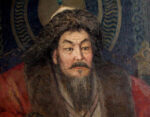Sean Connery rose to fame in the 1960s portraying a British secret agent. He became part of that decade’s British Invasion, which saw music, films, television programming, and fashion from the United Kingdom overwhelm cultures in Europe and North America. Yet throughout his long life, Connery recoiled at being called British. He was, loudly and proudly, a son of Scotland. He called himself a Scot and wore a clan’s kilt when he was knighted by Queen Elizabeth II in 2000.
Connery was not the first choice to play James Bond on film, and the fictional agent’s creator, Ian Fleming, openly disapproved of his casting. Yet Connery’s acting talents were such that he not only won over Fleming, but the writer added portions of Sean’s performance in new stories, including his Scottish background. Connery eventually tired of the role and branched out significantly, yet he remains the standard against which subsequent portrayers of Bond are measured.
Throughout his long career, he collaborated with distinguished directors such as John Huston, Sidney Lumet, and Alfred Hitchcock. He starred opposite notable actresses, including Tippi Hedren, Lana Turner, Catherine Zeta-Jones, Candice Bergen, and Gina Lollobrigida, to name a few. It was his Bond that introduced the bevy of actresses known to fans and film buffs as “Bond girls.” His film career spanned over 50 years and led to international acclaim. Yet, he is forever linked with the persona he created when he first uttered, “Bond…James Bond.”
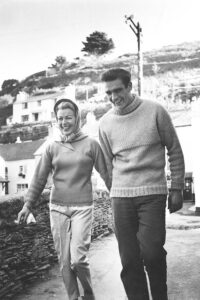
An Edinburgh Childhood
Thomas Sean Connery was born in Edinburgh on August 25, 1930, the first of two sons born to Joseph Connery and his wife, Euphemia MacLean Connery. As a child, he was called Tommy, a name he came to detest. By his mid-teens, he insisted on being called Sean, helped by the fact that he had a friend named Seamus. When the two were seen together in the neighborhood, they were called “Sean and Seamus”, and he found he preferred the name to Tommy.
Small as a young child, he experienced a growth spurt in his teens, growing to his adult height of 188 cm (6- 2) in his late teens. He worked as a milkman in his teens, learning the streets of Edinburgh with a precision that never left him. He hauled milk cans using a horse-drawn wagon. At 16, he joined the Royal Navy, and to celebrate the fact, he had himself tattooed. Eventually, he bore two tattoos, one reading Scotland Forever, the other Mum and Dad. During his brief naval career, he trained in gunnery and served as an able seaman aboard HMS Formidable, an aircraft carrier. Connery left the Navy in 1949 after being diagnosed with a congenital ulcer.
During his naval service, he took up serious bodybuilding. After his discharge, he worked in diverse jobs, including as a truck driver, a lifeguard, a coffin polisher, and as a nude model for artists. His bodybuilding led him to compete in various contests, including in the Mr. Universe contest, though sources differ as to when he competed and how he placed. His fondness for other athletic activities, including football, eventually led to his giving up bodybuilding, since increased body mass detracted from his overall athleticism. His football skills were sufficient to attract an offer to play professionally with Manchester United. Connery turned it down.
The Actor Emerges
Connery first came to the theater as a stagehand, attracted by the pay and by the actresses he met there. He first appeared onstage as an extra portraying one of the Seabees in a London production of South Pacific. He toured with the play, eventually taking over the lead role, formerly portrayed by the American actor Larry Hagman. As the almost stereotypical struggling young actor, he took diverse roles while working in odd jobs outside of the theater, including as a babysitter, while living in the homes of friends or employers.
By the late 1950s, Connery was appearing in small roles in films and television productions. During this phase of his career, he appeared alongside several notable actors of the day, including Herbert Lom, Van Johnson, and Patrick MacGoohan. He slowly graduated into bigger roles, often playing tradesmen. In 1958, he appeared in his first major role, opposite Lana Turner in the film Another Time, Another Place. His character was having an affair with Lana Turner’s character, which led to Turner’s boyfriend, a gangster named Johnny Stompanato, to assume the actors were conducting a real affair. Stompanato visited the set waving a gun, only to have Connery knock him to the floor after disarming him.
Stompanato was banned from the set and shortly afterwards left England, though Connery later reported that he was threatened by associates of American mobster Mickey Cohen. Stompanato was a known employee of Cohen’s. Whatever the threats were, they never materialized, and Stompanato was later stabbed and killed by Cheryl Crane, Lana Turner’s daughter. The killing was ruled a justifiable homicide by a coroner’s inquest.
By 1961, Connery had appeared in the lead role in several films, though his reviews were lackluster, and he lacked the status of a leading man in both London and Hollywood. It was then that he was approached to play the role of James Bond in the upcoming film Dr No. James Bond’s creator, Ian Fleming, was not enthralled with the choice.
Creating James Bond
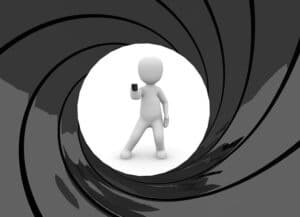
In his popular James Bond series of novels and short stories, Ian Fleming bestowed his British agent with clearly defined characteristics. Many of these were reflections of his own taste, such as Bond’s fondness for scrambled eggs, his drinking, and his tailor on Savile Row. He gave Bond his looks and style, and in Casino Royale, his character Vesper Lynd describes the agent. “Bond reminds me rather of Hoagy Carmichael…” He repeats the reference to the American piano player and actor in Moonraker, describing Bond as “Rather like Hoagy Carmichael in a way.”
When Fleming learned of Connery being favored for the role, he made a backhanded reference to the actor as “an over-developed stuntman”. Fleming also used words such as “unrefined” about Connery, and took umbrage with the actor being a “working class Scot”. Connery, ever proud of his Scottish heritage, later referred to Fleming as “a real snob”.
Despite his own misgivings with the role, Connery recognized the boost it would give his career and worked hard to win the part. He found allies in producer Cubby Broccoli and especially in Broccoli’s wife, Dana. Fleming continued to resist the choice, even when his long-time girlfriend informed him that Connery presented the sexual charisma necessary for the role. Fleming and Connery did not meet until filming was underway in Jamaica, where the author resided for several months of the year.
By then, Connery had created most of the indelible traits of the British super agent, including a distinctive walk, taught to him by director Terence Young. Young also introduced Connery to the clubs and gambling in London, tailored wardrobes, and had the actor inject a sense of humor into the character. Who originally came up with the introduction of “Bond…James Bond” is unknown, but in the film, Bond is actually parroting the character Sylvia Trench, who introduces herself as “Trench. Sylvia Trench.” He responds in kind.
Dr No had the lowest production budget of any Bond film, but Connery had signed a five-film deal when he accepted the role, giving him financial security. Dr No was released in 1962, to mixed reviews, but to immense success at the box office. The follow-up film, From Russia With Love (1963), cemented Sean Connery as James Bond in the eyes of fans around the world. Ian Fleming released a new Bond novel in March 1964 entitled You Only Live Twice. The eleventh novel in the series, it is the first to provide background on Bond’s early life. In the novel, Fleming gives his hero a Scottish father, and injects more humor in Bond than was present in earlier books. Clearly, Connery’s performance had impressed the writer.
Fleming did not live to see the third installment in the film series, Goldfinger (1964), dying the month before it was released. By then, Connery was already tiring of the role. During lapses in production of the Bond films, he stretched his acting career in several films, working with other directors and genres. One of them was suspense.
Alfred Hitchcock and Marnie
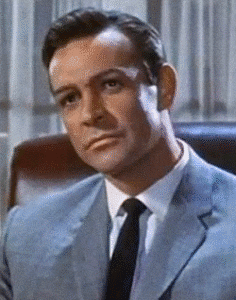
When Sean Connery signed his contract with Eon Productions, the producers of the Bond series, it included him in roles in other films besides Bond. He was concerned the success of Bond would limit the types of roles he was offered. He told Eon Productions that he wanted to work with Hitchcock, and Eon arranged a meeting with the director. Connery also asked to see a copy of the script for Marnie, concerned that it would be a spy-suspense story similar to North by Northwest, another Hitchcock film which had starred Cary Grant. When told that not even Grant had asked for a preview of a Hitchcock script, Connery replied, “I’m not Cary Grant.”
In Marnie, Connery played Mark Ruland, a wealthy publishing executive and widower, who is concerned with the title character’s aversion to the color red. Having previously stolen money from an employer and fled, Marnie applies for work with his publishing company and draws the attention of Ruland. He later learns of her stealing from his company, tracks her down, and blackmails her into marrying him. All the while, he struggles to understand her fear of the color red, as well as her sexual frigidity.
The role was as unlike James Bond as it could possibly be, and the film drew decidedly mixed reviews, with many panning both Connery and his costar, Tippi Hedren. The New Yorker called it a “…trashy movie with two terrible performances in the leading roles.” The New York Times referred to Connery and Hedren as “relative newcomers.” The film has earned a more laudable reputation over the years, and it made a profit at the box office, but it was hardly a rousing success for Connery or Hitchcock.
The same year, 1964, Connery played a lead role in Woman of Straw, with Gina Lollobrigida and Ralph Richardson. It too drew scathing reviews, with one critic, Eugene Archer of The New York Times, referring to it as a “hapless British film.”
1964 also saw the release of Goldfinger, followed the next year by Thunderball. Connery continued to cast about for roles outside of the James Bond genre in 1965’s The Hill, directed by Sidney Lumet. A film about a military prison, it featured Connery in the lead role, won numerous awards, and was a box office flop. Another flop featured Connery in 1966, A Fine Madness, in which he played a poet with writer’s block.
In 1967, Sean Connery went to Japan for the filming of You Only Live Twice. While there, it was announced it would be his final Bond film. He was tired of the role, and also of the international recognition of Sean Connery as James Bond. He had also created some controversy regarding his personal views.
Controversial Attitudes Towards Women
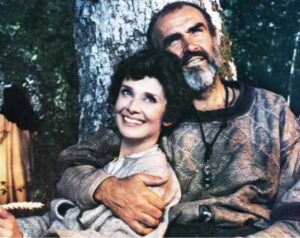
In November 1965, Sean Connery, then at the height of his popularity and with Bond mania rampant, gave an interview to Playboy Magazine. The interview was part of the pre-release publicity for the highly anticipated Thunderball. In the interview, Playboy quoted Connery as having said, “I don’t think there is anything particularly wrong with hitting a woman, though I don’t recommend you do it in the same way you hit a man”. Connery later denied he had made the remarks, claiming he was taken out of context. Nonetheless, they remained a part of his persona.
In 1985, when the James Bond of the sixties was long behind him, he appeared for an interview with Barbara Walters. When Walters brought up the remarks made to Playboy, Connery was unrepentant. Indeed, he amplified the earlier remarks. “I haven’t changed my opinion,” he said, adding, “It depends entirely on the circumstances and if it merits it”. After explaining that it should only be done as a last resort, he told Walters, “And women are pretty good at this; they can’t leave it alone. They want to have the last word, and you give them the last word, but they’re not happy with the last word. They want to say it again, and get into a really provocative situation. Then – I think it’s absolutely right.”
At the time of the Playboy interview, Connery was married to his first wife, Diane Cilento, an actress who appeared uncredited in several of the swimming scenes in Thunderball. They divorced in 1973. In 2006, Cilento released her autobiography, in which she alleged both physical and mental abuse were part of her marriage to Sean. Rumors of such abuse had arisen earlier, which Connery always denied while Cilento remained silent.
Connery was a long-time supporter of the Scottish National Party, which supports Scottish independence and withdrawal from the United Kingdom. When Cilento’s allegations appeared in 2006, coupled with the earlier comments to Playboy and Barbara Walters, he was forced to cancel a scheduled address before the Scottish Parliament. He issued a statement, through friends, saying, “I don’t believe that any level of abuse of women is ever justified under any circumstances”. Yet, his previously expressed views continued to haunt him for the rest of his life.
From Bond to Diversity
Sean Connery returned to the role of James Bond for 1971’s Diamonds Are Forever because he was offered a then-record $1.25 million for the role. The film is generally regarded as one of the worst in the entire Bond franchise, and easily his worst performance in the role. From then on, he put James Bond behind him. That is, until 1983, when he accepted the role in a non-Eon Productions remake of Thunderball, titled Never Say Never Again. The title was a reference to Connery’s dismissal of Bond following Diamonds Are Forever.
In between his final two Bond films, he branched out as an actor and the roles he agreed to play. He portrayed an aging Robin Hood in Robin and Marian, opposite Audrey Hepburn, to critical praise. He worked with his long-time friend Michael Caine as British adventurers in Tibet in The Man Who Would Be King. Another project that earned him praise was The Wind and the Lion, where he played a Moroccan brigand, Mulai Ahmed er Raisuni. Through the 1970s and 1980s, he averaged two or three films per year, shooting in locations all over the world.
He had a major hit in Europe with The Name of the Rose in 1986, though the film did not perform well in North America. Another film, which did resonate with American audiences, was 1987’s The Untouchables. For his role as Chicago police officer Jimmy Malone, he was awarded the Academy Award for Best Supporting Actor. In 1990, he appeared as a Lithuanian captain of a defecting Soviet submarine in The Hunt for Red October, another hit at the box office and with critics. Such was his enduring popularity that People Magazine named Connery the “Sexiest Man Alive” for 1989. He was then 59 years old.
He continued his torrid pace into the 1990s, staying busy with films into the 21st century. His final live-action film appeared in 2003, The League of Extraordinary Gentlemen, in which he played Alan Quatermain. Though the critics largely panned the film, it was another financial success.
The Church of Golf

The game of golf was invented in Scotland, and as a proud Scot, Sean Connery loved the game. He grew up near Bruntsfield Links, one of the world’s oldest golf courses, though as a youth his interests leaned towards football and swimming. He had played golf before Goldfinger, though sporadically. When it became apparent he would need to appear adept at the game for the film Goldfinger, he took lessons, and he quickly grew to love the game.
He became skilled enough that by the late 1960s, he was playing in pro-am events, club tournaments, and alongside numerous notables including Jack Nicklaus, Lee Trevino, three-time Formula 1 world champion Jackie Stewart, Bing Crosby, and many others.
In the 1990s, Sean Connery lived primarily in The Bahamas near Lyford Cay, with his second wife, Micheline. There he played golf almost daily, especially following his retirement from acting. He also played at renowned courses of the world, including St. Andrews and Royal Troon in the United Kingdom.
In his autobiography, Being a Scot (2008), Connery summed up his feelings about the game. “I began to see golf as a metaphor for living, for in golf you are basically on your own, competing against yourself and always trying to do better. If you cheat, you will be the loser because you are cheating yourself”. He then summed up his views on religion. “Over the years golf has taught me much, and its implicit codes of conduct have provided me with the nearest I have ever come to religion”.
A Changing Image
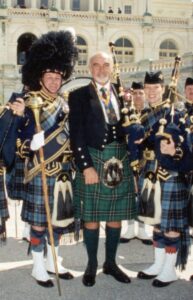
In the later years of his career, Sean Connery’s loss of hair was obvious. What is little-known today is that he was balding even before he accepted the role of James Bond in the early 1960s. Had it been widely known, it would have added to Ian Fleming’s objections to Connery in the role. As early as Dr No, Sean Connery appeared in the role of Bond wearing a hairpiece. The hairpieces grew larger as the film canon expanded.
To protect the image of James Bond in the early to mid-1960s, Connery wore a hairpiece for all public appearances. When he performed the role of Mark Ruland in Marnie, he again wore the hairpiece, lest the filmgoing public learn that James Bond was bald. As he grew apart from the role, his receding hairline was far less of a concern. His Robin Hood was clearly losing his hair, as was his character in The Man Who Would Be King. In The Wind and the Lion, his hairline was concealed, for the most part, by the costume he wore.
His image while portraying Bond was similar to the character: aloof, cool, always ready with a quick quip, the right wine, the perfect martini. Savile Row suits, fast cars, and gambling were part of his image, reinforced by the publicity arms of the studio. In truth, he was publicity shy, despised the public perception of him and James Bond being the same, and largely avoided the limelight and parties of Hollywood.
Between his marriages, he dated several high-profile women, including Lana Wood and Jill St. John, both of whom appeared on film with him. Others linked romantically to Connery included Dyan Cannon, former wife of Cary Grant. His first marriage, to Diane Cilento, led to the birth of a son, Jason. His second marriage was to Micheline Roquebrune in 1975, to whom he remained married until the end of his life.
A tax exile from Scotland, he lived in the south of France in the 1980s, owning an estate there. He relocated to the Bahamas in the 1990s and remained there as his primary residence following his retirement from acting in 2006.
A Political Pariah
Throughout his career and retirement, Sean Connery was a staunch supporter of Scottish independence. He helped fund events and made appearances aimed at gaining support for the separation of Scotland from the United Kingdom, though his status as a tax exile limited the time he could spend in his native country. It also provided fodder for those opposing such an action. To their criticism, Connery responded that he was not living as a tax exile, citing amounts of taxes he paid in the millions of pounds. In the late 1990s, he sold a villa he had owned in Spain, raising additional tax problems with the Spanish government. He was eventually cleared.
His tax issues and political views kept him from receiving a knighthood in the view of his supporters. That speculation ended when he was knighted by Queen Elizabeth II in 2000. The kilt he wore to appear before Her Majesty was of the Maclean clan, from which his mother had descended.
The following year, the British Parliament passed a law prohibiting political contributions from outside of the United Kingdom, bringing an end to Connery’s financial support of the Scottish National Party. Yet, he was not silenced. He continued to argue for Scottish independence, though as the 2010s wore on, his health began to fail and his public appearances were far less frequent.
In 2020, Sean Connery and his wife Micheline were photographed in the Bahamas as they celebrated their 45th wedding anniversary. By then, the actor was battling dementia as well as heart failure and other respiratory problems. Public appearances were rare, and he seldom left the gated community of Lyford Cay. On October 31, 2020, Connery died in his sleep at home at the age of 90. Nearly all of his obituaries referred to James Bond in their headlines.
After his body was cremated, plans were made to scatter the ashes in the Bahamas and Scotland. COVID delayed the plans until 2022. According to his son Jason, one site selected in Scotland was St Andrews, home of the R&A Trust Company Limited, which shares with the United States Golf Association the code of the rules of golf. Sean likely would have approved.


